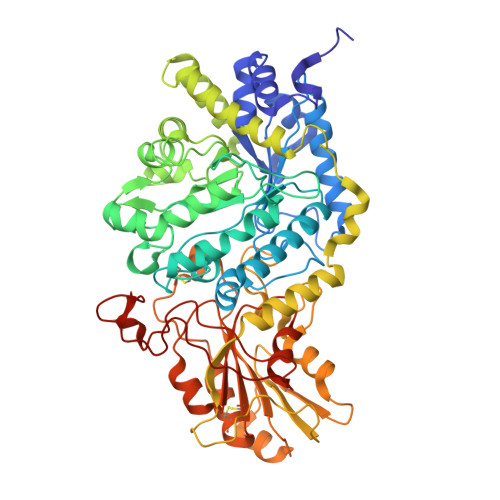The structure and dynamics of water molecule networks underlie catalytic efficiency in a glycoside exo-hydrolase.
Luang, S., Fernandez-Luengo, X., Streltsov, V.A., Marechal, J.D., Masgrau, L., Hrmova, M.(2025) Commun Biol 8: 729-729
- PubMed: 40348901
- DOI: https://doi.org/10.1038/s42003-025-08113-9
- Primary Citation of Related Structures:
8HJ6, 8HJ7, 8HJ8 - PubMed Abstract:
Glycoside hydrolases break glycosidic bonds by transferring a water molecule onto the glycosidic oxygen of carbohydrates, but on the nanoscale, the dynamics of water molecules remains unclear. We investigate the role of the non-nucleophilic E220 glutamate, essential for maintaining the water molecule network in a family 3 β-D-glucan glucohydrolase, but not involved directly in catalysis. Kinetic data disclose that the E220A mutant retains substrate poly-specificity but has drastically reduced catalytic efficiency compared to the wild-type. High-resolution structures in-complex with a hydrolytic product and a mechanism-based inhibitor reveal that in wild-type, the concatenated water molecules near acid/base E491 and neighbouring N219 and E220 form a harmonised network. In contrast, in the E220A mutant, this network is uncoordinated. Computational models of covalent complexes show that water flux through the wild-type protein correlates with high catalytic efficiency dissimilar to E220A, where this correlation is lost. Ancestral sequence reconstructions of family 3 enzymes divulge the evolutionary conservation of residues participating in water molecule networks, which underlie substrate-product-assisted processivity. Our findings provide a blueprint for the dynamics of catalysis mediated by hydrolytic enzymes, which could inspire bioengineering to create a sustainable bio-economy.
Organizational Affiliation:
School of Agriculture, Food and Wine, and Waite Research Institute, Faculty of Sciences, Engineering and Technology, University of Adelaide, Adelaide, SA, Australia.






















